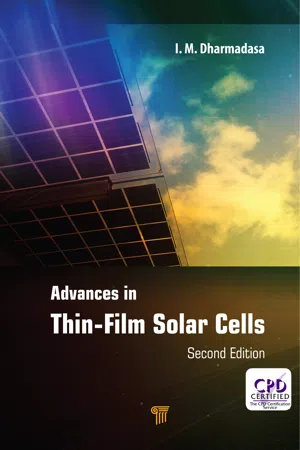![]()
Contents
Preface to the Second Edition
List of Symbols and Abbreviations
1 Photovoltaic Solar Energy Conversion
1.1 Introduction
1.2 Photovoltaic Effect
1.3 Solar Energy Materials
1.4 Electronic Devices Used for Solar Energy Conversion
1.4.1 p-n Junctions
1.4.2 p-i-n Junctions
1.4.3 Hetero-junctions
1.4.4 n-n and p-p Junctions
1.4.5 Metal/Semiconductor (or Schottky) Contacts
1.4.6 Metal/Insulator/Semiconductor Interfaces
1.5 Characteristics of a Solar Cell
1.5.1 I-V Characteristics of a Solar Cell Under Dark Conditions
1.5.2 I-V Characteristics of a Solar Cell Under Illuminated Conditions
1.5.3 How to Maximise Voc
1.5.4 How to Maximise Jsc
1.5.5 How to Maximise FF
1.6 Summary
Exercises
2 Status Report on Solar Energy Technologies
2.1 Introduction
2.2 Si Solar Cell Technology
2.4 PV Technology Based on III-V Compounds
2.5 Disruptive Technology for PV Development
2.6 Emerging Low-Cost Thin-Film Technologies
2.7 Next-Generation Solar Cells
2.8 Summary
Exercise
3 Electrochemical Deposition of Solar Energy Materials
3.1 Introduction
3.2 Electrodeposition of Semiconductors
3.3 Strengths and Advantages of Electrodeposition
3.3.1 Simplicity, Low-Cost, Scalability, and Manufacturability
3.3.2 Self-Purification and Built-In Hydrogen Passivation
3.3.3 Extrinsic and Intrinsic Doping
3.3.4 Ability in Bandgap Engineering
3.3.5 Other Advantages of Electrodeposition
3.4 Experimental Evidence
3.4.1 Observations in XRD
3.4.2 Observations in XRF
3.4.3 Observations in PEC Cell Measurements
3.4.4 Observations in Optical Absorption Measurements
3.4.5 Observations in Photoluminescence
3.4.6 Impurity Control in Semiconductors
3.5 Issues in Electrodeposition of Semiconductors
3.6 Summary of Electroplated Materials to Date
3.7 Applications in PV Devices
3.8 Summary
Exercises
4 Background of the CdTe Solar Cell and the New Device Concept
4.1 Introduction
4.2 The Previous Model for a Glass/Conducting Glass/CdS/CdTe/Metal Solar Cell
4.3 Key Observations That Led to the Formulation of a New Model
4.3.1 Surface Modification of CdTe
4.3.2 Effects of Surface Modification on Defect Levels
4.3.3 Effects of Defect Levels on Electronic Devices
4.3.4 Similar Observations on Thin-Film CdS/CdTe Solar Cells
4.4 New Concept for CdS/CdTe Solar Cell
4.5 Description of Experimental Results Using the Two Models
4.5.1 Current-Voltage (I-V) Characteristics
4.5.2 Capacitance-Voltage (C-V) Characteristics
4.5.3 Electron Beam-Induced Current Measurements
4.5.4 Observation of Discrete Barrier Heights and Voc Values
4.5.5 A Thin-Film CdTe Solar Cell Device Without a CdS Layer
4.5.6 Results from Electrical Contacting Work
4.5.7 Doping of CdS and CdTe Layers
4.5.8 Further Experimental Evidence to Confirm the True Structure of the Device
4.6 Predictions for the Further Development of CdS/CdTe Solar Cells and Latest Observations
4.6.1 Doping of Window and Absorber Materials with n-Dopants
4.6.2 Improvements to Back Contact Using MIS-Type Structures
4.6.3 A Multi-layer Graded Bandgap Approach
4.6.4 Dealing with Defects
4.6.5 Progress during the Period 2011-2016
4.7 Summary
Exercises
5 Extension of the New Model to CIGS Thin-Film Solar Cells
5.1 Introduction
5.2 Summary of Accumulated Knowledge on CIGS-Based Materials
5.2.1 Different Growth Techniques
5.2.2 Structural, Optical, and Electrical Properties
5.2.3 Ordered Defect Compound Layer
5.2.4 Latest Developments in Materials Growth
5.3 Summary of Accumulated Knowledge on CIGS-Based Solar Cells
5.3.1 Conventional Device Structure
5.3.2 Frequently Used Energy Band Diagram
5.4 Current Views of the Physics Behind CIGS Solar Cells
5.4.1 p-CIGS/n-CdS Hetero-junction
5.4.2 p-CIGS/n-CIGS Homo-junction
5.4.3 p-CIGS/n-ODC Hetero-junction
5.5 Reported Device Performance
5.6 Recent Work on Metal/p-CIGS Interfaces
5.7 Deeper Understanding of Mo/CIGS/CdS/ i-ZnO/n-ZnO:Al/Metal-Grid Solar Cells
5.7.1 Type I CIGS-Based Solar Cell
5.7.2 Type II CIGS-Based Solar Cell
5.8 Discussion on Further Improvements of CIGS Solar Cells
5.8.1 Optimisation of Growth, Doping, and Bandgap Engineering
5.8.2 Defect Level Identification and Engineering
5.8.3 Growth of CIGS with Controlled Orientation
5.8.4 Replacement of Mo Using TCO for Tandem and Double-Faced Solar Cells
5.8.5 Further Improvements of the Device Structure
5.9 Conclusions
5.10 Summary
6 Effective Harvesting of Photons
6.1 Introduction
6.2 Tandem Solar Cells
6.2.1 Connection in Series
6.2.2 Connection in Parallel
6.3 Comparison of the Two Connecting Methods
6.3.1 Disadvantages of Series Connections
6.3.2 Advantages of Parallel Connections
6.4 Conclusions
6.5 Summary
Exercise
7 Multi-layer Graded Bandgap Solar Cells
7.1 Introduction
7.1.1 Incorporation of the Impurity PV Effect
7.1.2 Incorporation of Impact Ionisation
7.2 Summary of Growth and Process Details of the Device Structure
7.3 Experimental Results of Fully Processed Devices
7.3.1 Electrical Properties Under Dark Conditions
7.3.2 Electrical Properties Under AM1.5 Illumination
7.3.3 IPCE Measurements
7.3.4 EBIC Measurements
7.3.5 SIMS Profiling
7.3.6 Optimisation of Si Doping Concentration
7.4 Discussions
7.5 Summary
Exercise
8 Solar Cells Active in Complete Darkness
8.1 Introduction
8.2 ...
